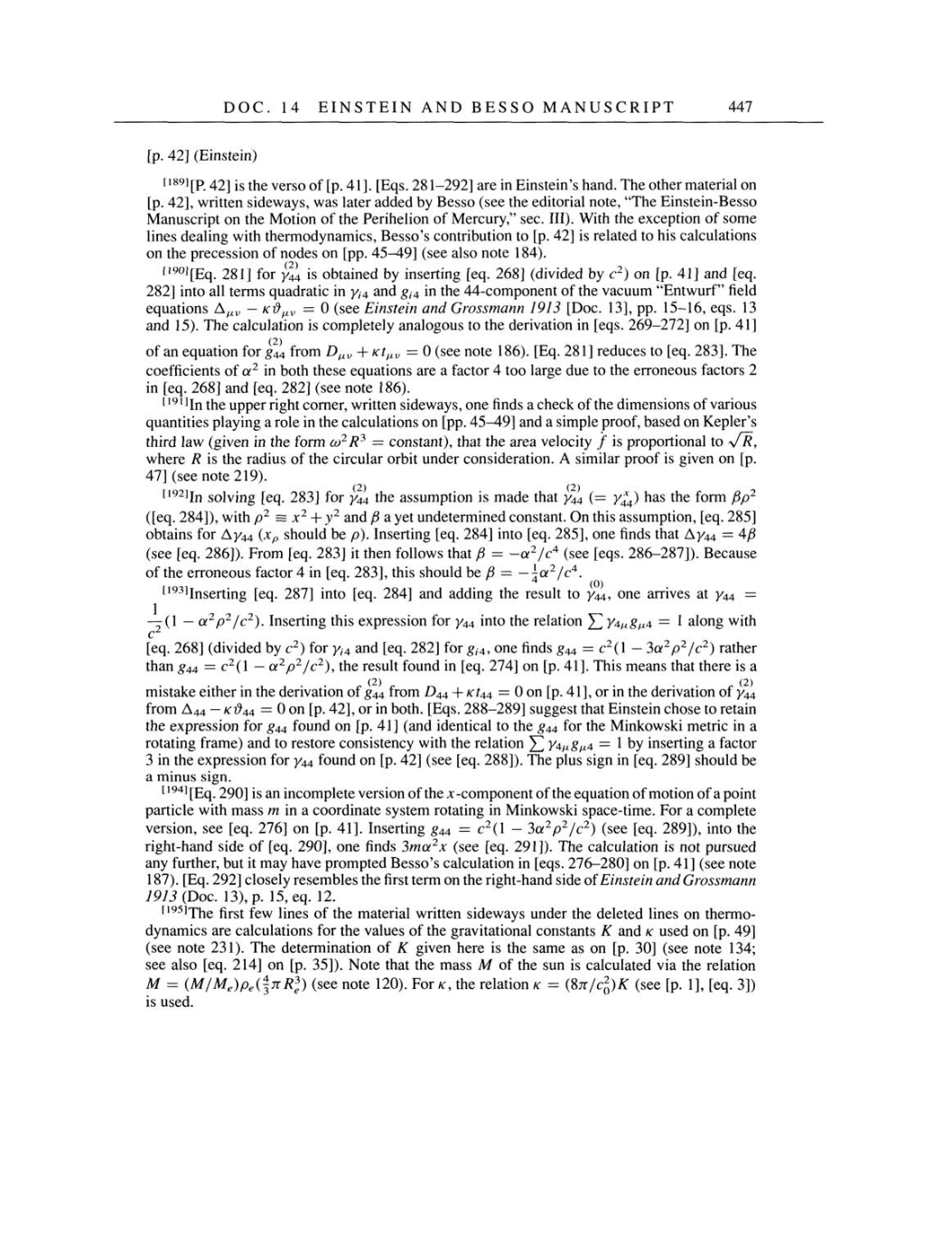DOC.
14
EINSTEIN
AND
BESSO MANUSCRIPT 447
[p.
42] (Einstein)
[189][p
42]
is
the
verso
of
[p. 41]. [Eqs.
281-292]
are
in
Einstein's hand. The other material
on
[p.
42],
written
sideways,
was
later added
by
Besso
(see
the editorial
note,
"The Einstein-Besso
Manuscript on
the Motion of
the
Perihelion
of
Mercury,"
sec.
III).
With the
exception
of
some
lines
dealing
with
thermodynamics,
Besso's contribution
to
[p.
42]
is
related
to his
calculations
on
the
precession
of nodes
on
[pp.
45-49] (see
also
note
184).
[190][Eq.
281]
for
y44(2)
is obtained
by
inserting
[eq. 268]
(divided
by
c2)
on [p.
41]
and
[eq.
282]
into all
terms quadratic
in
yi4
and
gi4
in
the
44-component
of
the
vacuum
"Entwurf"
field
equations
Auv
-
K0uv =
0
(see
Einstein and Grossmann
1913
[Doc. 13], pp.
15-16,
eqs.
13
and
15).
The calculation is
completely analogous to
the derivation
in
[eqs.
269-272]
on [p.
41]
of
an
equation
for
g44(2)
from
D^v
+
Kt^v
=0
(see note
186). [Eq. 281]
reduces
to
[eq. 283].
The
coefficients of
a2 in
both these
equations are
a
factor 4
too
large
due
to
the
erroneous
factors 2
in
[eq.
268]
and
[eq.
282] (see
note
186).
[191]In the
upper right corner,
written
sideways,
one
finds
a
check of
the
dimensions of
various
quantities playing
a
role
in
the calculations
on
[pp.
45-49] and
a simple proof,
based
on Kepler's
third
law
(given
in
the form
w2R3
=
constant), that
the
area
velocity
f
is
proportional
to
VR,
where
R is
the radius of the circular orbit under consideration.
A
similar
proof is given on [p.
47]
(see note 219).
[192]In solving
[eq.
283]
for
y44(2)
the
assumption
is
made that
y44(2)
(=
yx44)
has
the
form
ßp2
([eq.
284]),
with
p2
=
x2
+
y2
and
ß
a yet
undetermined
constant. On this
assumption,
[eq.
285]
obtains for
Ay44 (xp
should
be
p). Inserting
[eq.
284] into
[eq.
285],
one
finds
that
Ay44
=
4ß
(see
[eq.
286]).
From
[eq.
283]
it then follows that
ß
=
-a2/c4
(see
[eqs.
286-287]).
Because
of
the
erroneous
factor
4 in
[eq.
283], this
should
be ß
=
-1/4a2/c4.
[193]Inserting [eq.
287]
into
[eq.
284]
and adding
the result
to
y44(0),
one
arrives at
y44
=
1/c2(l
-
a2p2/c2).
Inserting this expression
for
y44
into the relation
E
y4ugu4
=
1
along
with
[eq.
268] (divided
by c2)
for
yi4
and
[eq. 282]
for
gi4,
one
finds
g44
=
c2(1
-
3a2p2/c2)
rather
than
g44
=
c2(1
-
a2p2/c2),
the result found
in
[eq.
274]
on [p.
41].
This
means
that there
is
a
mistake either
in
the derivation of
g44(2)
from
D44
+
Kt44
=
0
on
[p.
41],
or
in
the derivation of
y44(2)
from
A44
-
kü44
=
0
on
[p.
42],
or
in both.
[Eqs.
288-289]
suggest
that Einstein chose
to
retain
the
expression
for
g44
found
on
[p.
41]
(and
identical
to
the
g44
for the Minkowski metric
in
a
rotating
frame)
and
to restore
consistency
with the relation
y4/xg/x4
= 1
by
inserting
a
factor
3
in
the
expression
for
y44
found
on [p.
42]
(see
[eq.
288]).
The
plus
sign
in
[eq. 289]
should
be
a
minus
sign.
[194][Eq.
290]
is
an
incomplete
version of the
x-component
of
the equation
of
motion
of
a
point
particle
with
mass m
in
a
coordinate
system rotating
in
Minkowski
space-time.
For
a
complete
version,
see [eq.
276]
on [p.
41].
Inserting
g44
=
c2(1
-
3a2p2/c2)
(see [eq.
289]),
into the
right-hand
side of
[eq.
290],
one
finds
3ma2x
(see
[eq.
291]). The
calculation
is
not
pursued
any
further, but it
may
have
prompted
Besso's calculation
in
[eqs.
276-280]
on [p.
41]
(see note
187). [Eq. 292]
closely
resembles the
first
term
on
the
right-hand
side
of
Einstein
and
Grossmann
1913
(Doc. 13),
p. 15, eq.
12.
[195]The first few
lines of the material written
sideways
under the deleted lines
on
thermo-
dynamics are
calculations for the values of
the
gravitational
constants K and
k
used
on
[p. 49]
(see note 231).
The determination of
K
given
here
is
the
same
as on [p. 30]
(see note
134;
see
also
[eq.
214] on
[p.
35]).
Note that the
mass
M of the
sun
is
calculated via
the relation
M
= (M/Me)pe(4/3nR3e)
(see
note
120).
For
k,
the relation
k
=
(8n/c20)K
(see
[p. 1], [eq.
3])
is used.
